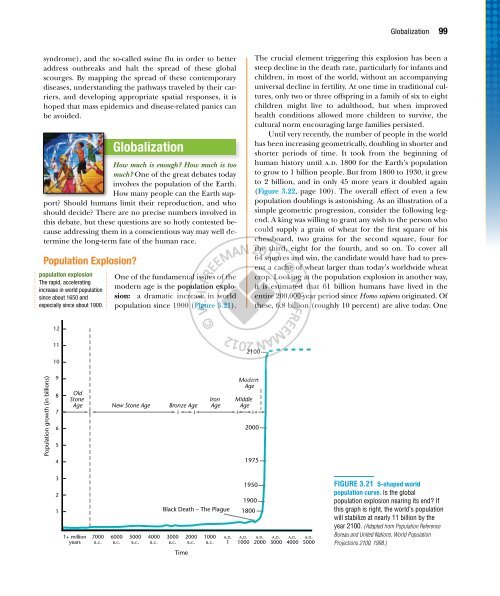Chapter 3 Population Geography - W.H. Freeman
Chapter 3 Population Geography - W.H. Freeman
Chapter 3 Population Geography - W.H. Freeman
Create successful ePaper yourself
Turn your PDF publications into a flip-book with our unique Google optimized e-Paper software.
Globalization 99<br />
syndrome), and the so-called swine flu in order to better<br />
address outbreaks and halt the spread of these global<br />
scourges. By mapping the spread of these contemporary<br />
diseases, understanding the pathways traveled by their carriers,<br />
and developing appropriate spatial responses, it is<br />
hoped that mass epidemics and disease-related panics can<br />
be avoided.<br />
Globalization<br />
How much is enough? How much is too<br />
much? One of the great debates today<br />
involves the population of the Earth.<br />
How many people can the Earth support?<br />
Should humans limit their reproduction, and who<br />
should decide? There are no precise numbers involved in<br />
this debate, but these questions are so hotly contested because<br />
addressing them in a conscientious way may well determine<br />
the long-term fate of the human race.<br />
<strong>Population</strong> Explosion?<br />
population explosion<br />
The rapid, accelerating<br />
increase in world population<br />
since about 1650 and<br />
especially since about 1900.<br />
One of the fundamental issues of the<br />
modern age is the population explosion:<br />
a dramatic increase in world<br />
population since 1900 (Figure 3.21).<br />
The crucial element triggering this explosion has been a<br />
steep decline in the death rate, particularly for infants and<br />
children, in most of the world, without an accompanying<br />
universal decline in fertility. At one time in traditional cultures,<br />
only two or three offspring in a family of six to eight<br />
children might live to adulthood, but when improved<br />
health conditions allowed more children to survive, the<br />
cultural norm encouraging large families persisted.<br />
Until very recently, the number of people in the world<br />
has been increasing geometrically, doubling in shorter and<br />
shorter periods of time. It took from the beginning of<br />
human history until a.d. 1800 for the Earth’s population<br />
to grow to 1 billion people. But from 1800 to 1930, it grew<br />
to 2 billion, and in only 45 more years it doubled again<br />
(Figure 3.22, page 100). The overall effect of even a few<br />
population doublings is astonishing. As an illustration of a<br />
simple geometric progression, consider the following legend.<br />
A king was willing to grant any wish to the person who<br />
could supply a grain of wheat for the first square of his<br />
chessboard, two grains for the second square, four for<br />
the third, eight for the fourth, and so on. To cover all<br />
64 squares and win, the candidate would have had to present<br />
a cache of wheat larger than today’s worldwide wheat<br />
crop. Looking at the population explosion in another way,<br />
it is estimated that 61 billion humans have lived in the<br />
entire 200,000-year period since Homo sapiens originated. Of<br />
these, 6.8 billion (roughly 10 percent) are alive today. One<br />
12<br />
11<br />
2100<br />
10<br />
<strong>Population</strong> growth (in billions)<br />
9<br />
8<br />
7<br />
6<br />
5<br />
4<br />
Old<br />
Stone<br />
Age New Stone Age Bronze Age<br />
Iron<br />
Age<br />
Modern<br />
Age<br />
Middle<br />
Age<br />
2000<br />
1975<br />
3<br />
2<br />
1<br />
1+ million<br />
years<br />
7000<br />
B.C.<br />
6000<br />
B.C.<br />
5000<br />
B.C.<br />
4000<br />
B.C.<br />
Black Death – The Plague<br />
3000<br />
B.C.<br />
Time<br />
2000<br />
B.C.<br />
1000<br />
B.C.<br />
A.D.<br />
1<br />
1950<br />
1900<br />
1800<br />
A.D.<br />
1000<br />
A.D.<br />
2000<br />
A.D.<br />
3000<br />
A.D.<br />
4000<br />
A.D.<br />
5000<br />
Figure 3.21 S-shaped world<br />
population curve. Is the global<br />
population explosion nearing its end? If<br />
this graph is right, the world’s population<br />
will stabilize at nearly 11 billion by the<br />
year 2100. (Adapted from <strong>Population</strong> Reference<br />
Bureau and United Nations, World <strong>Population</strong><br />
Projections 2100, 1998.)

















